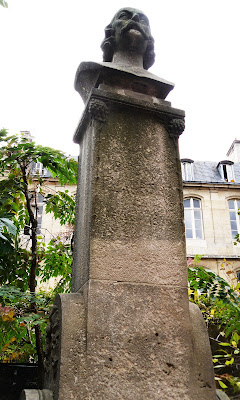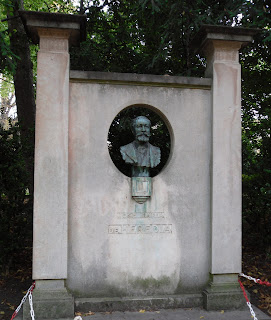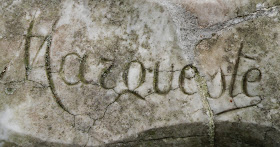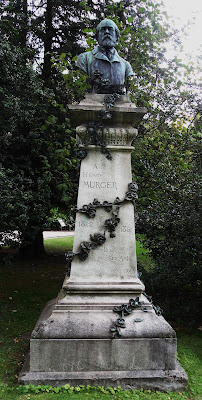The Stefan Zweig monument was erected in 2003 as a tribute to the Austrian novelist, playwright, journalist and biographer (1881–1942) who first traveled to France in 1902.
The statues of Montesquieu and Étienne Pasquier aren't as clearly visible as the other statues. It may well be possible to see them close up, but it is by no means obvious, which is a pity.
Paul Verlaine's marble bust was sculpted by Auguste de Niederhausen Rodo, and the women emerging from the stone represent the three souls of Verlaine: the religious, the sensual, and the childlike. Oh, and that's a pigeon on his head. At least it's better than a traffic cone - see the Diderot post.
Jean-Antoine Injalbert's monument to the Belfort-born poet Gabriel Vicaire went up in the garden in 1902. He is perhaps best known for his collection Emaux Bressans (1884).
The poet Louis Ratisbonne was a librarian at the Palais du Luxembourg, and the statue was erected in the gardens in 1911. It remembers his children's poems and fables, Comédie Enfantine (1860).
The Comptesse de Ségur (1799-1874) was a children's writer and of the 18 writers' monuments in the Jardin du Luxembourg, hers is only one two. She was of Russian descent.
Charles Baudelaire, whose monument was moved to a more frequented position in the park in 1966 to accord more with the greatness of the poet and the importance of the sculptor, Pierre Fixe-Masseux.
The quotation is the final verse from his poem 'Les Phares':
'Car c'est vraiment, Seigneur, le meilleur témoignage
Que nous puissions donner de notre dignitéQue cet ardent sanglot qui roule d'âge en âge
Et vient mourir au bord de votre éternité!'
I was so impressed by Laurent Marqueste's representation of Ferdinand Fabre, a novelist noted for his blend of French and Occitan, that I spent several minutes admiring it and taking photos of it. I didn't realize that a man had been watching my activities and was just bursting to tell me his piece of ironic Gallic observation: 'Monsieur, il a le droit de vous rendre hommage'. Lovely. Ah, the French.

Gustave Flaubert (1821-1880) was born in Rouen and died in Canteleu, a hamlet in Croisset. Jean-Baptiste Clesinger was responsible for this work, which was erected in 1922.
Stendhal (1783-1842) was born Henri Bayle in Grenoble, perhaps changing his name after Johann Joachim Winckelmann, the founder of modern archaeology, perhaps after his beloved Shetland(s), of which 'Stendhal' is an anagram.
'This bronze medallion representing Stendal, together with a simple plinth, was sculpted by Rodin from a drawing by the sculptor David d'Angers.'
George Sand (1804-76) is a pseudonym of d'Amantine Aurore Lucile Dupin, and François-Léon Sicard sculpted this, which was erected in 1904.
'Inauguré en 1898, le monument à Leconte de Lisle, chef de file de l'Ecole parnassienne, représente une muse ailée enlaçant de ses bras le buste du poéte qui fut également bibliothéaire au Sénat.'
'Inaugurated in 1898, the monument dedicated to Leconte de Lisle, leader of the Parnassian school, represents a winged muse wrapping her arms around the bust of the poet, who was also a librarian of the Sénat.'
–––––––––––––––––––––––––––––––––––
Vassilis Alexakis: L'Enfant grec (2012)




































I just added this site to my rss reader, excellent stuff. Can't get enough!
ReplyDelete